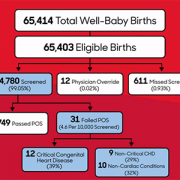European workgroup creates recommendations for CCHD pulse oximetry screening

Several experts, including Gerard R. Martin, M.D., recently published recommendations for the use and standardization of pulse oximetry screening for critical congenital heart defects in newborns.
The European Pulse Oximetry Screening Workgroup recently published recommendations for the use and standardization of pulse oximetry screening for critical congenital heart defects in newborns. Children’s National Medical Director of Global Services Gerard R. Martin, M.D., was among the experts that compiled the recommendations.
Approximately 1 in 500 babies is born with a critical congenital heart defect (CCHD). Because these conditions can cause serious, life-threatening symptoms, early detection and intervention is essential. Pulse oximetry screening (POS) – a method that measures oxygen saturation – is regarded as a simple, quick and reliable tool for early detection of CCHD, and was recommended for use in screening by the American Academy of Pediatrics and the American Heart Association in 2011.
In Europe, although POS is being used by an increasing number of hospitals, few countries have issued national guidelines recommending universal POS. To remedy this situation, neonatologists, experts in CCHD screening, and representatives from major scientific pediatric societies across Europe came together to create recommendations for the use and standardization of POS for early detection of CCHD across Europe.
Their recommendations, which were published in The Lancet, are as follows:
- POS for critical congenital heart defects should be recommended for all European countries
- POS should be done with new-generation equipment that is motion tolerant
- Screening should occur after 6 hours of life or before discharge from the birthing centre (preferably within 24 hours after birth)
- Screening should be done in two extremities: the right hand and either foot
- Each country should consider the advantages and disadvantages of the two available protocols and use that which best suits their population











